Norwegian Cruise Line Holdings Bundle
Who Really Calls the Shots at Norwegian Cruise Line Holdings?
Ever wondered who steers the ship at one of the world's leading cruise line companies? The ownership structure of Norwegian Cruise Line Holdings (NCLH) is a fascinating blend of institutional investors and public shareholders, shaping its strategic decisions and market performance. Understanding the Norwegian Cruise Line Holdings SWOT Analysis is critical for any investor or analyst.
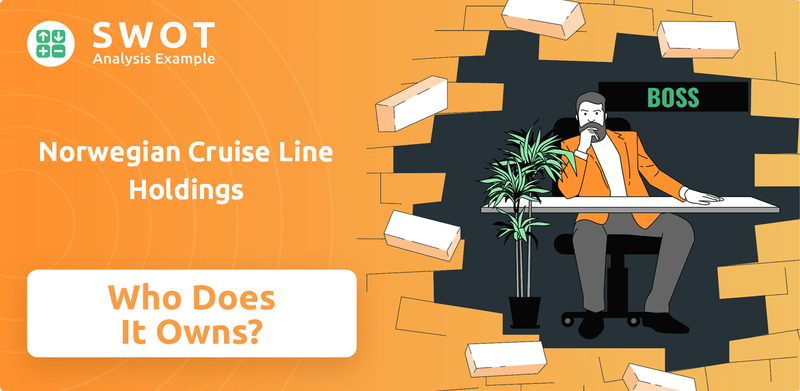
From its origins as Norwegian Caribbean Line to its current status as a publicly traded cruise line company, NCLH's ownership has undergone significant transformations. This exploration of NCLH ownership will reveal the key players, from early founders to today's major shareholders, and how their influence affects the company's trajectory. Knowing who owns NCL is crucial for anyone looking to understand the dynamics of this major player in the cruise industry.
Who Founded Norwegian Cruise Line Holdings?
The story of Norwegian Cruise Line Holdings (NCLH) begins with its founders, Knut Kloster and Ted Arison. They launched the company, originally named Norwegian Caribbean Line, in 1966. Their vision was to provide accessible and enjoyable cruise vacations, marking the start of a major player in the cruise line company industry.
Knut Kloster, with a background in the family's shipping business, brought extensive maritime experience. Ted Arison, an Israeli-American businessman, later became the founder of Carnival Cruise Line. While the exact initial ownership breakdown isn't available in public records, Kloster and Arison were the key initial owners.
The early days of Norwegian Cruise Line were driven by the entrepreneurial spirit of Kloster and Arison. They focused on expanding the cruise market, which influenced the company's fleet development and the itineraries offered. The company's early operational and strategic decisions were centered around their vision.
Knut Kloster and Ted Arison founded Norwegian Cruise Line in 1966. Kloster's maritime experience and Arison's business acumen were crucial.
The founders aimed to offer affordable cruise vacations. This focus shaped the company's early strategies and offerings.
Specific details on the initial ownership split are not publicly available. Kloster and Arison were the primary owners.
The early phase was marked by the founders' drive to grow the cruise market. There is no information about early agreements.
Early decisions focused on fleet development and itinerary offerings. These decisions were based on the founders' vision.
The founding team's vision of expanding the cruise market was central. This influenced the company's early operational strategies.
Early investors beyond the founders are not extensively documented. The focus was on the entrepreneurial efforts of Kloster and Arison. For more insights into the company's strategic direction, consider reading about the Growth Strategy of Norwegian Cruise Line Holdings. As of early 2024, the company's market capitalization was approximately $7.5 billion. The company operates a fleet of around 29 ships, serving various destinations. The current CEO is Harry Sommer. Understanding the initial ownership helps in grasping the evolution of this major cruise line.
Norwegian Cruise Line Holdings SWOT Analysis
- Complete SWOT Breakdown
- Fully Customizable
- Editable in Excel & Word
- Professional Formatting
- Investor-Ready Format
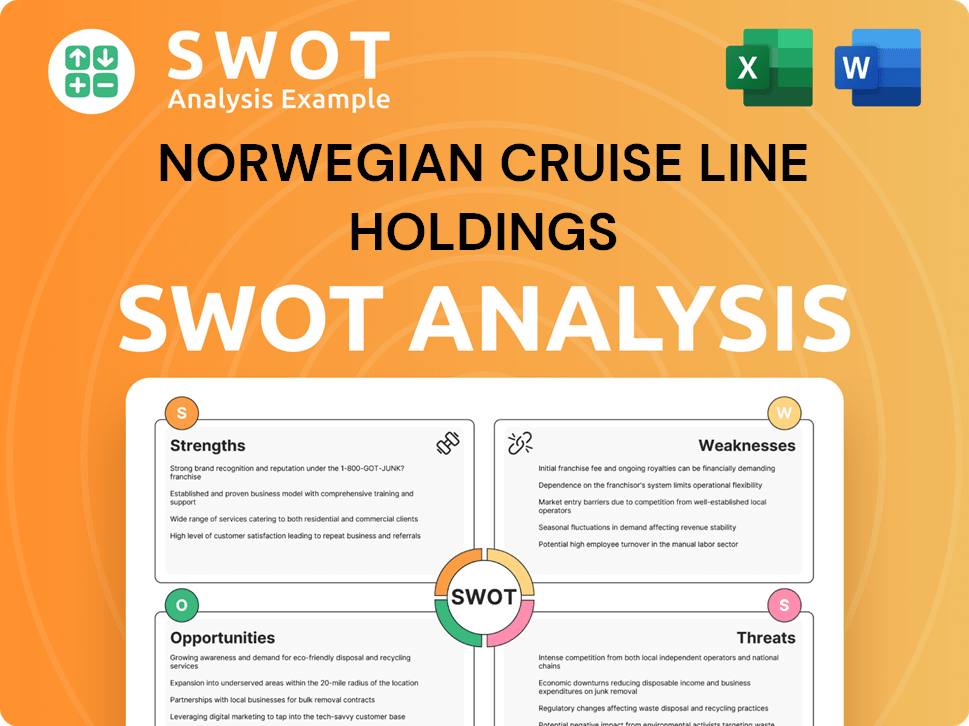
How Has Norwegian Cruise Line Holdings’s Ownership Changed Over Time?
The ownership structure of Norwegian Cruise Line Holdings (addressing the question of 'Who owns NCL') has evolved significantly since its inception. A crucial development was its Initial Public Offering (IPO) on January 18, 2013. This event, which saw the company begin trading on the NASDAQ Global Select Market under the ticker symbol 'NCLH,' marked a transition from private to public ownership, opening the door for wider market participation. Before the IPO, significant private equity involvement came from Apollo Global Management, LLC, and Genting Hong Kong Limited. For more details, you can check out the Brief History of Norwegian Cruise Line Holdings.
The IPO was a pivotal moment that transformed the company's ownership landscape. It allowed for greater investor participation and introduced increased scrutiny from public markets. This shift also brought about changes in corporate governance and strategic decision-making, as the company became more accountable to a broader range of shareholders.
| Ownership Event | Date | Impact |
|---|---|---|
| IPO | January 18, 2013 | Transition from private to public ownership, increased market participation. |
| Pre-IPO Ownership | Prior to 2013 | Significant private equity ownership by Apollo Global Management and Genting Hong Kong Limited. |
| Current Ownership | Q1 2025 | Dominance of institutional investors, influencing corporate strategy and governance. |
As of Q1 2025, institutional investors hold the majority of NCLH's stock, answering the question of 'Cruise line owner'. Major stakeholders include prominent asset management firms and mutual funds. Vanguard Group Inc. and BlackRock Inc. are consistently among the top institutional holders. Recent SEC filings and market data indicate that institutional ownership of NCLH is approximately 90-95%. Individual insider ownership, including executives and board members, usually remains in the low single digits. This high level of institutional ownership influences company strategy, focusing on shareholder value and corporate governance, impacting decisions on capital allocation, fleet expansion, and dividend policies.
The ownership of Norwegian Cruise Line Holdings has shifted significantly over time, from private equity to predominantly institutional investors. This shift has influenced the company's strategic direction and governance practices.
- Institutional investors hold the largest share of NCLH's stock.
- The IPO in 2013 was a major event that changed the ownership structure.
- The focus is on shareholder value and corporate governance.
- Understanding the ownership structure is crucial for investors.
Norwegian Cruise Line Holdings PESTLE Analysis
- Covers All 6 PESTLE Categories
- No Research Needed – Save Hours of Work
- Built by Experts, Trusted by Consultants
- Instant Download, Ready to Use
- 100% Editable, Fully Customizable
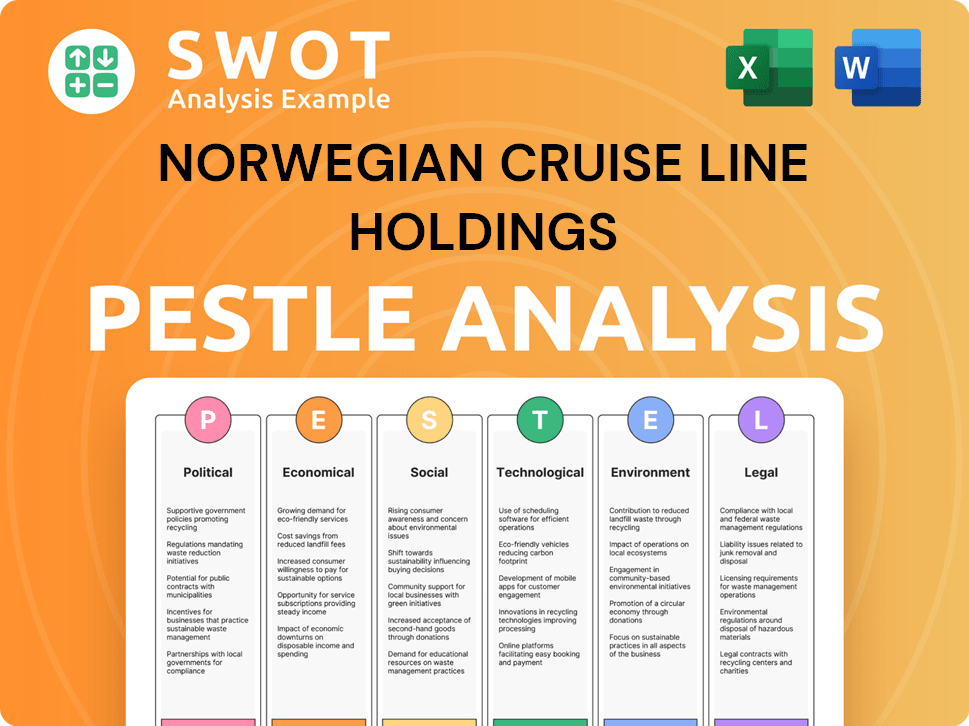
Who Sits on Norwegian Cruise Line Holdings’s Board?
As of early 2025, the Board of Directors of Norwegian Cruise Line Holdings (NCLH) includes a mix of independent directors and individuals with extensive experience in the cruise and travel industries. The board's composition reflects a commitment to strong corporate governance, often influenced by the presence of significant institutional investors. These independent directors are crucial in providing a balanced perspective and ensuring that the board fulfills its fiduciary duties to all shareholders. The board's structure aims to maintain a balance between industry expertise and independent oversight.
The board's decisions, including executive compensation, capital expenditures, and strategic direction, are made in alignment with the interests of its diverse shareholder base, primarily its institutional investors. The focus is on maintaining a stable and effective governance structure to navigate the complexities of the cruise line industry. The board's role is critical in overseeing the company's performance and ensuring long-term value for its shareholders. For further insights into the company's operations, consider exploring the Revenue Streams & Business Model of Norwegian Cruise Line Holdings.
| Board Member | Title | Relevant Experience |
|---|---|---|
| Harry Sommer | President and Chief Executive Officer | Extensive experience in the cruise industry, including leadership roles at other cruise lines. |
| Adam Goldstein | Lead Independent Director | Former CEO of Royal Caribbean Cruises Ltd., bringing deep industry knowledge. |
| Wendy Needham | Independent Director | Experience in finance and investment management, providing financial oversight. |
The voting structure of NCLH is based on a one-share-one-vote principle, common for publicly traded companies. There are no publicly disclosed details of dual-class shares or special voting rights that would grant outsized control to specific individuals. The company's governance practices are designed to protect shareholder interests and ensure fair representation. The absence of complex voting structures promotes transparency and aligns the interests of management with those of the shareholders.
Understanding the board of directors and voting power is crucial for investors in Norwegian Cruise Line Holdings. The board's composition and voting structure reflect a commitment to good corporate governance. This structure aims to protect shareholder interests and ensure fair representation.
- The board includes independent directors and industry experts.
- Voting is based on a one-share-one-vote principle.
- Institutional investors significantly influence governance.
- The board focuses on long-term shareholder value.
Norwegian Cruise Line Holdings Business Model Canvas
- Complete 9-Block Business Model Canvas
- Effortlessly Communicate Your Business Strategy
- Investor-Ready BMC Format
- 100% Editable and Customizable
- Clear and Structured Layout
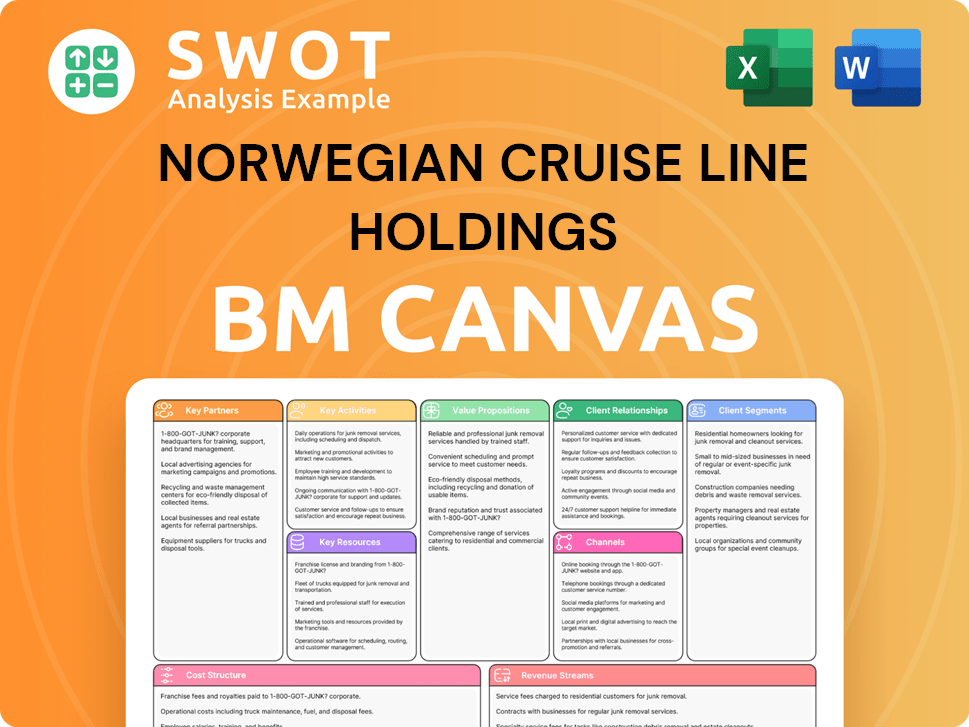
What Recent Changes Have Shaped Norwegian Cruise Line Holdings’s Ownership Landscape?
Over the past few years, the ownership structure of Norwegian Cruise Line Holdings (NCLH) has been relatively stable. The company has seen consistent high levels of institutional ownership. Q1 2025 financial reports indicate that major asset managers hold significant stakes in the cruise line company. This reflects a mature public company with a diverse investor base, predominantly driven by institutional capital.
In the context of the cruise industry, mergers and acquisitions are typically large-scale events. However, NCLH has focused on organic growth through new ship deliveries and itinerary expansions rather than acquiring other major cruise lines. Leadership changes haven't significantly impacted the ownership profile. The company's focus has been on managing its debt and liquidity following the global travel disruptions. Industry-wide trends, such as increased institutional ownership and ESG considerations, have influenced NCLH's reporting and operational strategies.
| Metric | Value | Source |
|---|---|---|
| Market Capitalization (as of May 2024) | Approximately $7.6 Billion | Yahoo Finance |
| Institutional Ownership (Q1 2024) | Approximately 70% | Financial reports |
| Number of Ships (as of May 2024) | Approximately 30 | Company Website |
The ownership trends of NCLH continue to reflect a mature public company. There have been no public statements about potential privatization or major shifts in its public listing status. The company's focus remains on operational efficiency and strategic growth within the existing framework.
Major institutional investors hold significant positions in NCLH. These include large asset management firms and investment funds. Their ownership reflects confidence in the cruise line's long-term prospects. These investors help to drive the stock price and company strategies.
NCLH has shown signs of recovery in recent financial reports. The company has focused on improving its financial position. Revenue and occupancy rates have been increasing. The company is working to manage its debt and improve profitability.
The cruise line company is expected to continue expanding its fleet. NCLH is focusing on enhancing guest experiences. The company will likely continue to navigate industry challenges. The ownership structure is expected to remain relatively stable.
Investors should consider the company's debt levels and market conditions. Analyze the impact of geopolitical events on the cruise industry. Monitor the company's ability to manage costs and generate revenue. Consider the long-term growth potential.
Norwegian Cruise Line Holdings Porter's Five Forces Analysis
- Covers All 5 Competitive Forces in Detail
- Structured for Consultants, Students, and Founders
- 100% Editable in Microsoft Word & Excel
- Instant Digital Download – Use Immediately
- Compatible with Mac & PC – Fully Unlocked
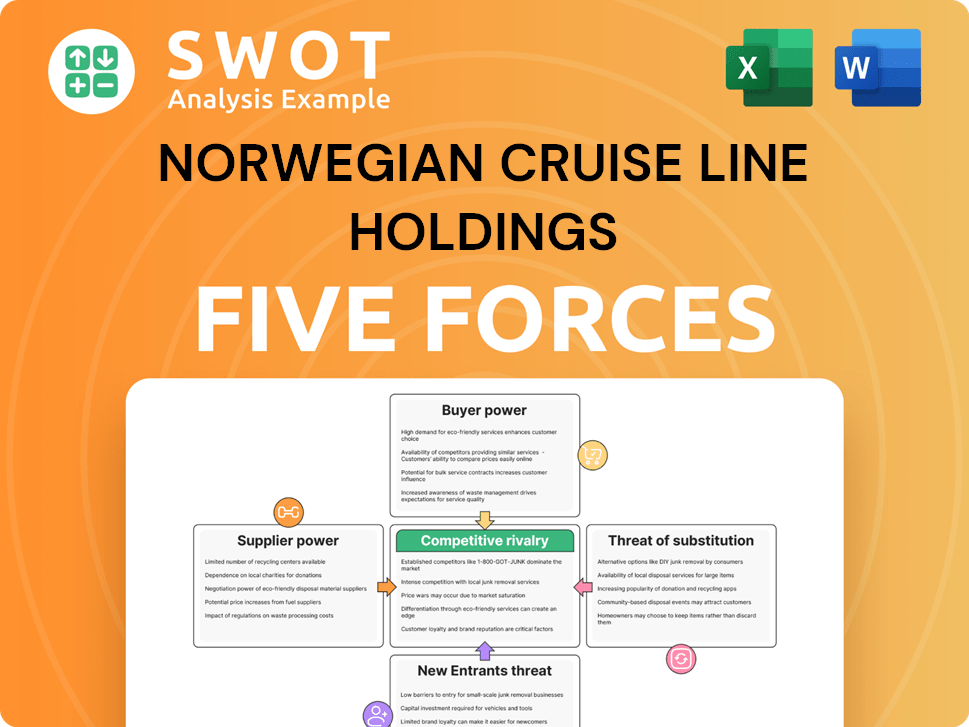
Related Blogs
- What are Mission Vision & Core Values of Norwegian Cruise Line Holdings Company?
- What is Competitive Landscape of Norwegian Cruise Line Holdings Company?
- What is Growth Strategy and Future Prospects of Norwegian Cruise Line Holdings Company?
- How Does Norwegian Cruise Line Holdings Company Work?
- What is Sales and Marketing Strategy of Norwegian Cruise Line Holdings Company?
- What is Brief History of Norwegian Cruise Line Holdings Company?
- What is Customer Demographics and Target Market of Norwegian Cruise Line Holdings Company?
Disclaimer
All information, articles, and product details provided on this website are for general informational and educational purposes only. We do not claim any ownership over, nor do we intend to infringe upon, any trademarks, copyrights, logos, brand names, or other intellectual property mentioned or depicted on this site. Such intellectual property remains the property of its respective owners, and any references here are made solely for identification or informational purposes, without implying any affiliation, endorsement, or partnership.
We make no representations or warranties, express or implied, regarding the accuracy, completeness, or suitability of any content or products presented. Nothing on this website should be construed as legal, tax, investment, financial, medical, or other professional advice. In addition, no part of this site—including articles or product references—constitutes a solicitation, recommendation, endorsement, advertisement, or offer to buy or sell any securities, franchises, or other financial instruments, particularly in jurisdictions where such activity would be unlawful.
All content is of a general nature and may not address the specific circumstances of any individual or entity. It is not a substitute for professional advice or services. Any actions you take based on the information provided here are strictly at your own risk. You accept full responsibility for any decisions or outcomes arising from your use of this website and agree to release us from any liability in connection with your use of, or reliance upon, the content or products found herein.